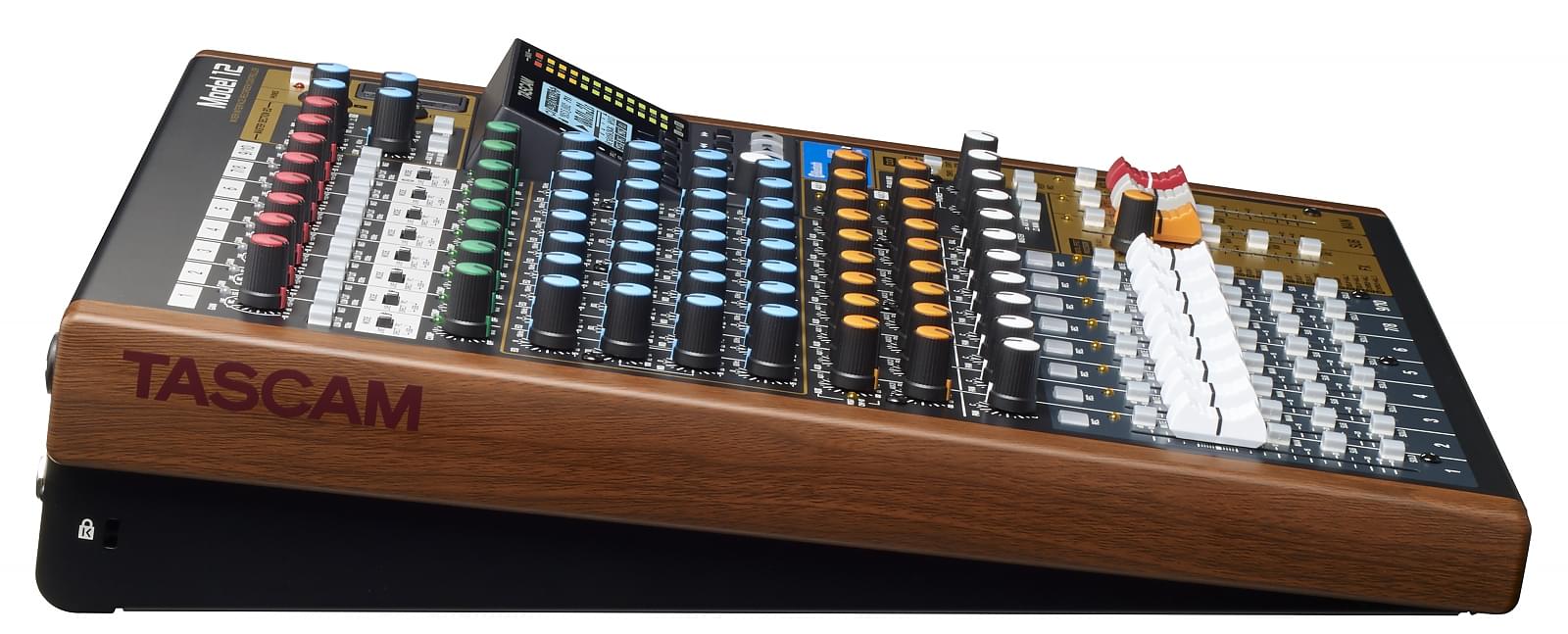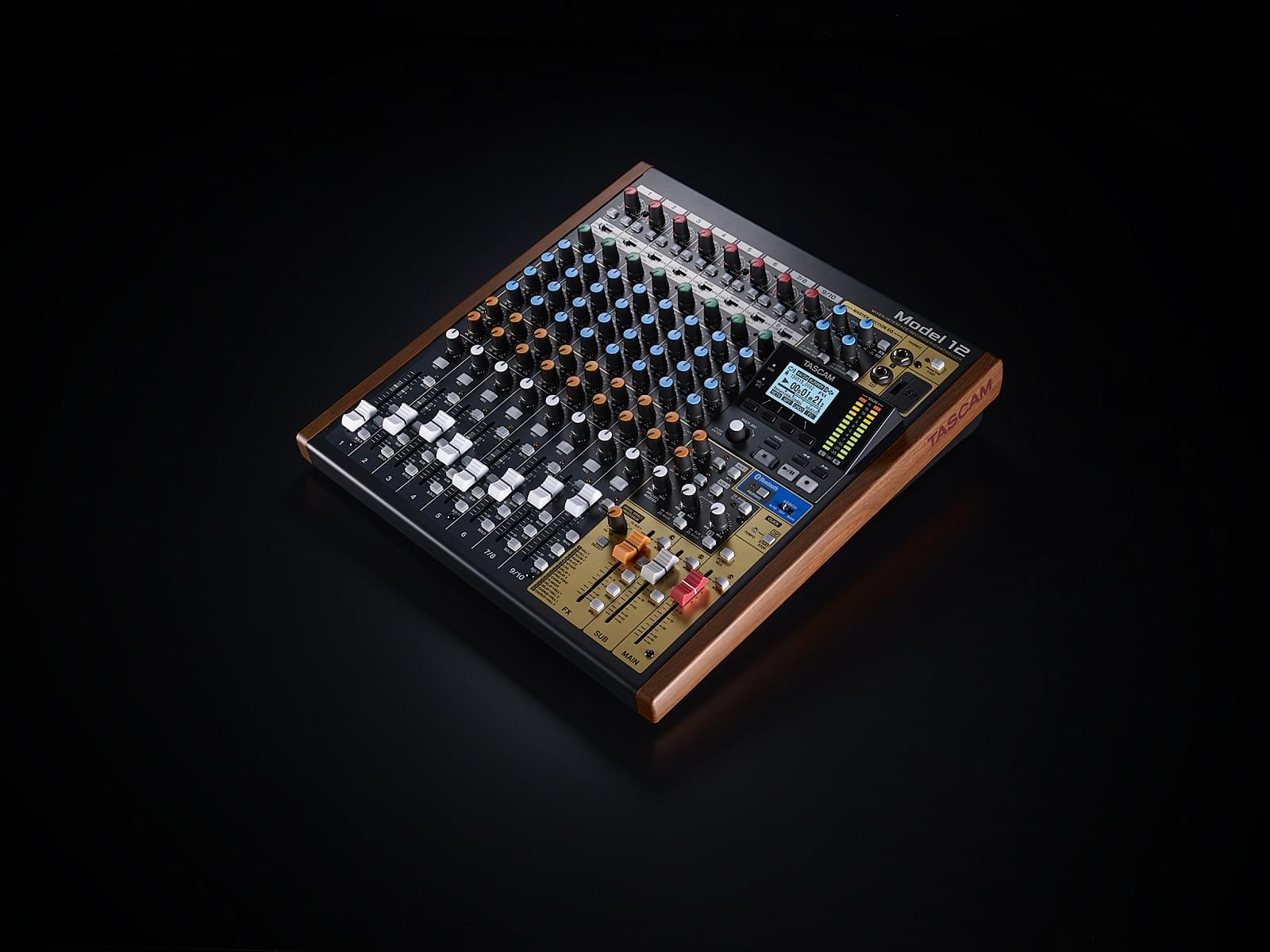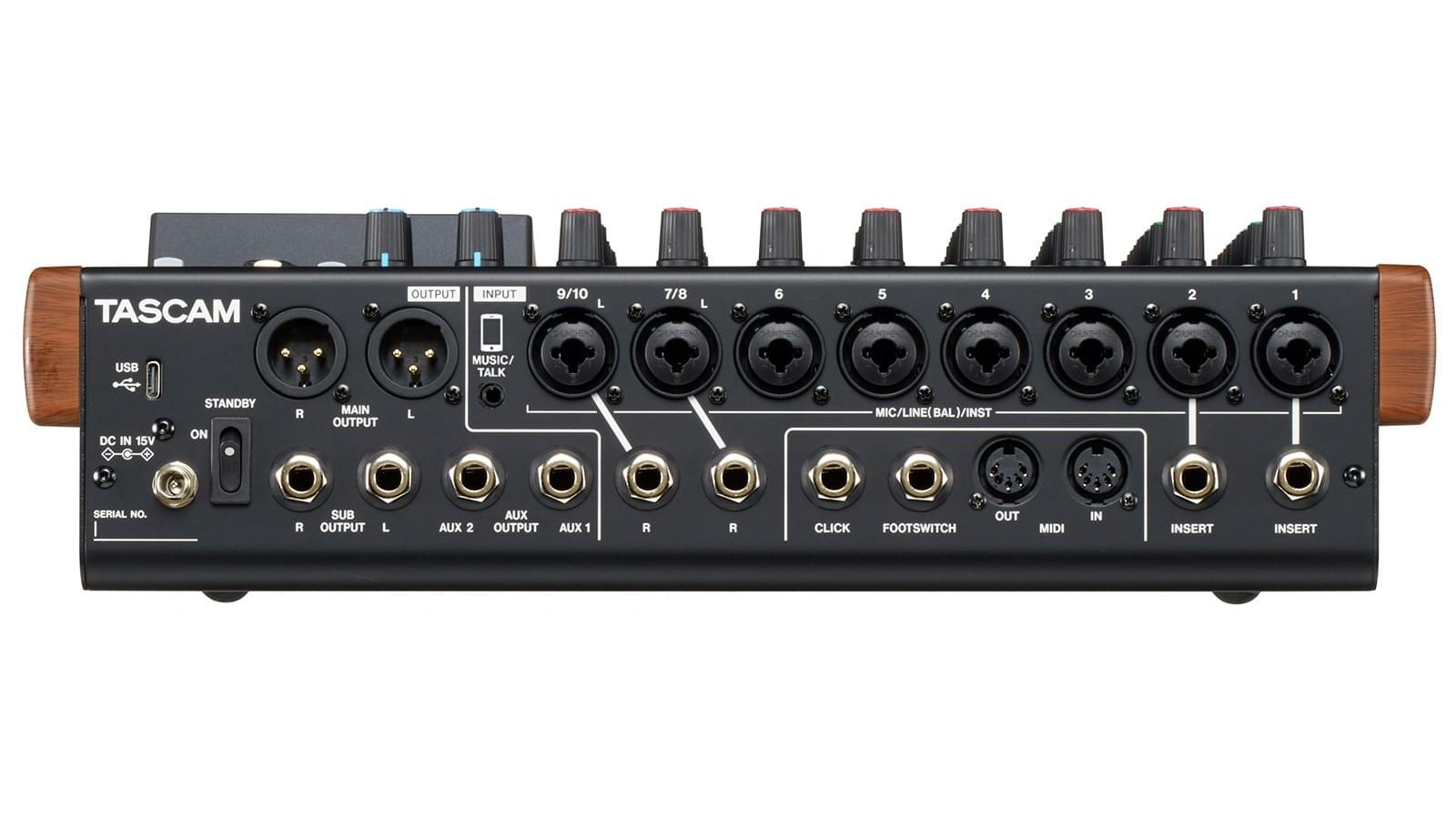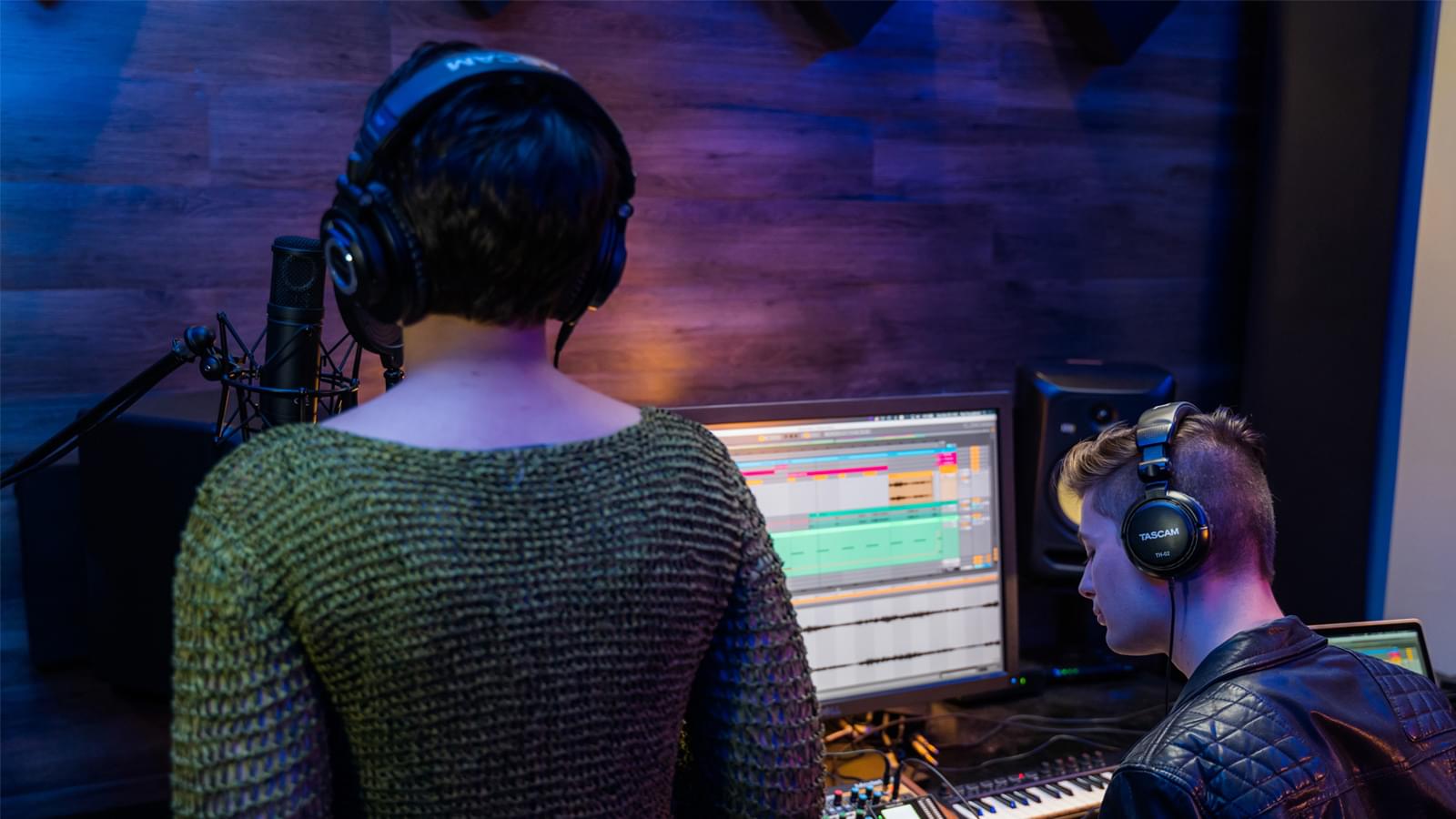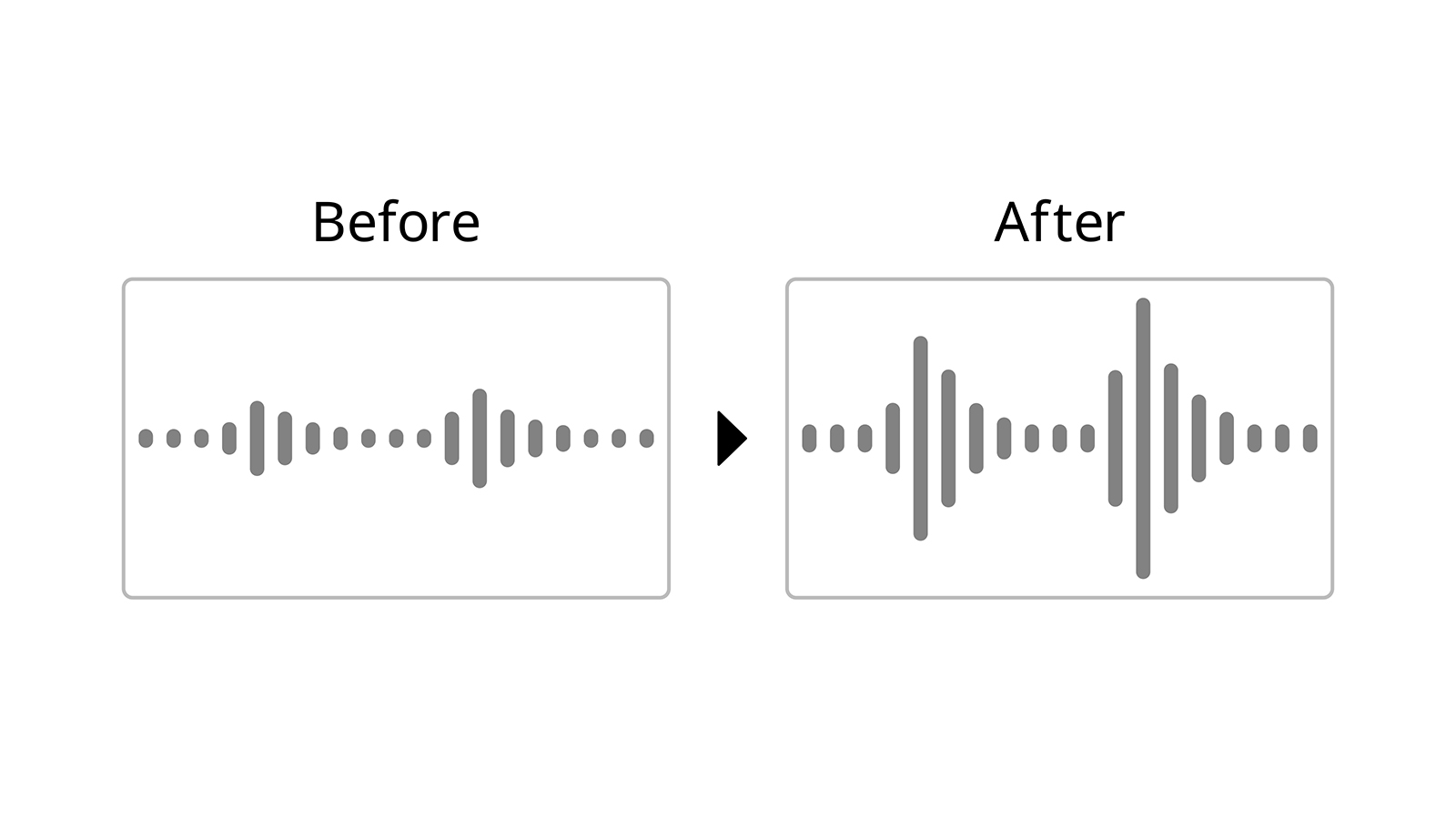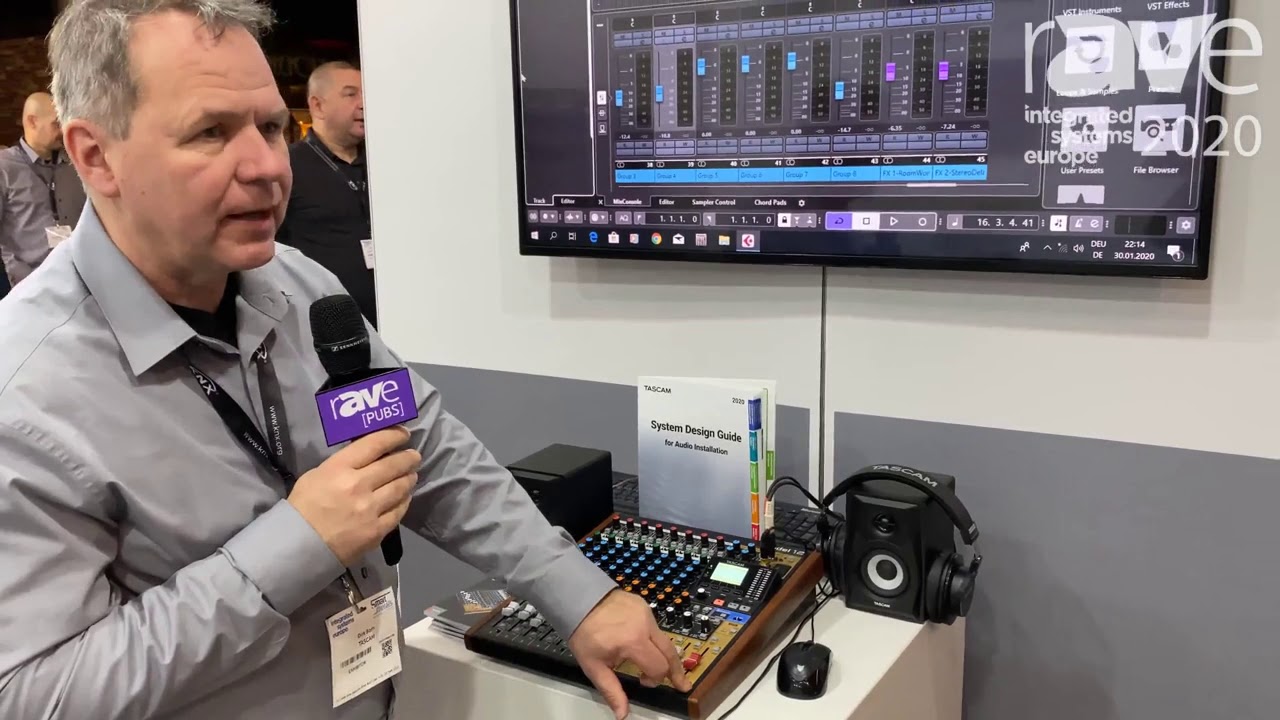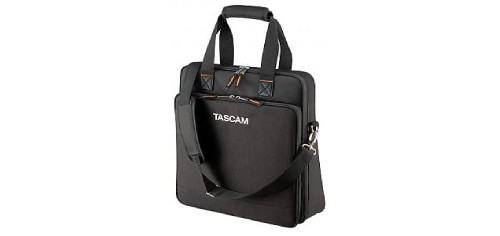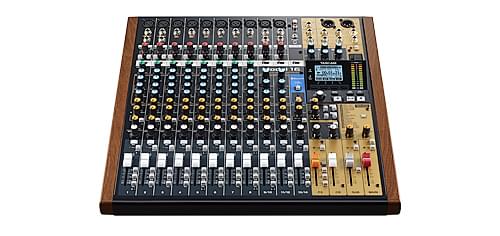Model 12
Mixer / Interface / Recorder / Controller
Integrated Production Suite
The Perfect Tool
For Music and Multimedia Creators
Tascam Model 12 is a compact all-in-one integrated mixing and recording suite designed for music and multimedia creators, songwriters and performers. It consists of a 10-input mixer, a 12-track version of the highly acclaimed Tascam multi-track audio recorder, USB audio interface, MIDI connectivity, DAW control functions, and unique podcasting capability including mix-minus and smartphone input.
Combining the feel of an analogue user interface with the efficient workflow and pristine quality associated with digital recording and production, the compact and affordable Model 12 supports your creative process from start to finish.

12-Track Recording and 10-Track Playback
The Model 12’s intuitive internal 12-track recorder creates WAV files of up to 24-bit/48 kHz audio quality directly to an SD card. Up to ten tracks can be played back simultaneously. Supporting metronome, punch-in/out, and overdubbing functions, the internal recorder also allows WAV files to be imported from another Tascam Model Series mixer like the Model 12, Model 16 or Model 24. And, of course, it is possible to export tracks in WAV file format which can then be imported directly into a DAW for further editing or production.

12 In / 10 Out USB Audio Interface for DAW Connectivity
A USB connector facilitates connecting a computer to the Model 12 for playback and recording utilizing a wide range of popular DAWs. Sounds can be recorded in a DAW to create precise and original tracks, and then played back during live performances using Model 12 only. The USB audio interface can be used simultaneously with the built-in multi-track recorder. Model 12 also supports class compliant mode and can be connected to Apple iOS devices using an optional adapter.
DAW Control Integration
Basic control for an external DAW using HUI/MCU protocol emulation is integrated for tactile control of most major DAWs. Controllable parameters include Faders, Mutes, Pans, Solos, Record Arm, Play, Record, Stop, FF/Rew and Jog.
Logic / Cubase / Pro Tools / Ableton Live (external links to Youtube)

Combine Your Setup With MIDI Equipment
Standard MIDI input and output make it possible to use keyboards, drum machines, controllers, and other sources that employ MIDI technology with the Model 12. This also allows playback-start commands to be triggered or external multi-track recorders and other external MIDI devices to be synchronized with the Model 12.

Podcast Your Latest Music and Live Performances to Your Fan Base
The Model 12 incorporates several features for podcasting and internet streaming like mix-minus, smartphone input, multiple mic-ready channels, Bluetooth pairing, dual headphone monitoring, and internal multi-track recording. Use the Model 12 as a versatile live production recorder, USB audio interface and live streaming tool.
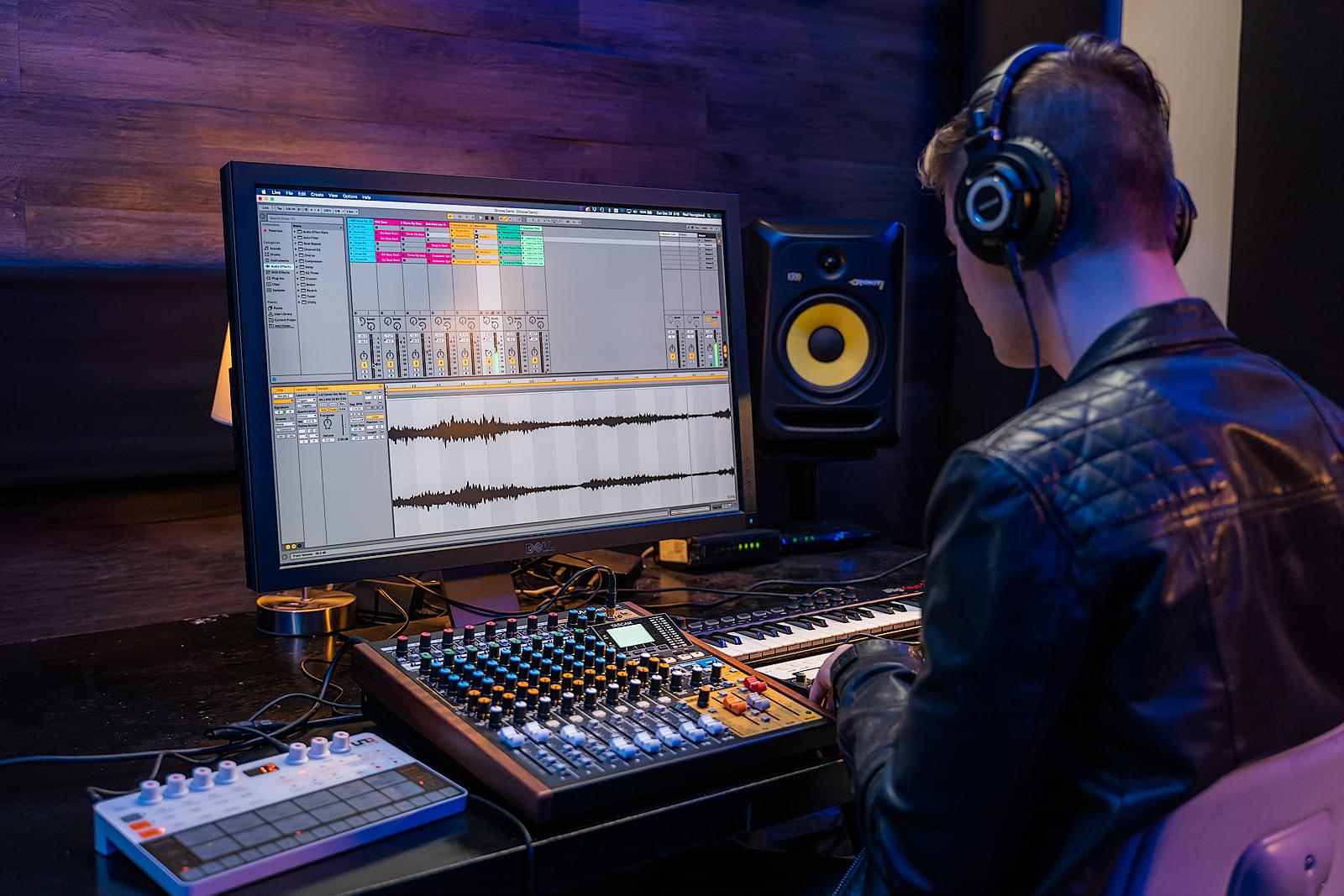
All-in-One Audio Production From Recording to Mastering
The Model 12’s seamless integrated workflow facilitates less focus on the technical and more on the creative part. The built-in multi-track recorder allows one-button recording and playback. And the comfortable, familiar feel of the 60-mm faders, one-knob compressor, three-band EQ, and high-quality Tascam effects enable fast and intuitive tweaking of mixes and tones.

Monitor Your Signals on a Computer (added in v1.50)
Connect the Model 12 to a PC or Mac via USB to access the Model Mixer Settings Panel app and take advantage of a digital meter bridge. Use it to monitor the input, multitrack or USB signal and adjust the peak hold times. Scale the window to suit your needs, or for an even better experience, display the app on a separate monitor.
Details
Tutorial Videos
Set up and record
Learn how to set up the Tascam Model 12 and record your first song
What’s new in v1.30
Learn about the new features introduced with firmware version 1.30
DAW controller for Cubasis
How to use the Model 12 as a DAW controller with Steinberg Cubasis.
DAW controller for Reaper
How to use the Model 12 as DAW controller with Reaper.
DAW controller for Studio One
How to use the Model 12 as DAW controller with Presonus Studio One.
Comparison of Model Series Mixers

|

|

|

|
|
|---|---|---|---|---|
| Model 2400 | Model 24 | Model 16 | Model 12 | |
| Mixer | ||||
| Number of Input Channels | 22 | 22 | 14 | 10 |
| Mic Inputs | 16 × XLR | 16 × XLR | 10 × XLR | 8 × XLR |
| Line Inputs | 22 (20 × TRS + 2 × TS) | 22 (20 × TRS + 2 × RCA) | 14 (12 × TRS + 2 × RCA) | 10 (10 × TRS, 3.5-mm TRRS jack) |
| Instrument Inputs | 2 (CH 1–2) | 2 (CH 1–2) | 2 (CH 1–2) | 8 (CH 1-8) |
| Channel Inserts | CH 1–12 | CH 1–2 | CH 1–2 | CH 1–2 |
| 48V Phantom Power | Groups of 4 ch | All at Once | All at Once | All at Once |
| Bluetooth® | ||||
| Mic Preamps | Ultra-HDDA | Ultra-HDDA | Ultra-HDDA | Ultra-HDDA |
| Compressors | CH 1–12 | CH 1–12 | CH 1–8 | CH 1–10 |
| AUX/FX Sends | 5 | 3 | 3 | 2 |
| Master EQ/COMP | 4-Band Parametric EQ, Stereo Compressor |
7-Band Graphic EQ | 4-Band Parametric EQ | 3-Band Parametric EQ |
| MAIN L/R Output | ||||
| SUB Outputs | 8 Subgroups | |||
| AUX Outputs | 5 | 3 | 3 | 2 |
| Headphones Outputs | 2 | 1 | 1 | 2 |
| Multi-Track Recorder | ||||
| Recording Channels | 24 (22 ch + 2 stereo mix) | 24 (22 ch + 2 stereo mix) | 16 (14ch + 2 stereo mix) | 12 (10 ch + 2 stereo mix) |
| Recording Media | SD / SDHC / SDXC | SD / SDHC / SDXC | SD / SDHC / SDXC | SD / SDHC / SDXC |
| Audio Interface | ||||
| Inputs / Outputs | 24 / 22 | 24 / 22 | 16 / 14 | 12 / 10 |
| Supported OS | Windows / macOS / iOS / iPadOS | Windows / macOS / iOS / iPadOS | Windows / macOS / iOS / iPadOS | Windows / macOS / iOS / iPadOS |
| Other Functions | ||||
| MIDI Interface | ||||
| DAW Control Functions | ||||
| Click Output With Tap Tempo | ||||
| Metronome | ||||
| VAMP Playback Function | ||||
| Output Delay Function | ||||
| Settings Panel App With Digital Meterbridge | ||||
| Operation With Streaming Apps Such As OBS Studio | ||||
Features at a glance
- 10-channel mixer with built-in 12-track recorder and USB audio interface
Mixer features
- Ten analogue inputs on six mono and two stereo channels
- Eight mono mic inputs on XLR connectors with switchable phantom power (48 V)
- Ultra-HDDA microphone preamps on inputs 1–6
- Eight channels can be used with high-impedance instruments like electric guitars/basses
- Ten balanced line inputs (six mono, two stereo)
- Multi-purpose stereo channel for input from mobile devices via Bluetooth or TRRS smartphone connector (CH 9/10)
- Inserts on input channels 1 and 2
- Mix-minus function on smartphone mini-jack input
- Two Aux outputs (monitor, effects) and two stereo outputs with independent master faders (Main, Sub)
- Monitoring can be selected between PFL (pre-fader), AFL (after-fader) and SIP (solo-in-place)
- Dedicated click output with tap tempo feature
- One-knob compressor for all input channels
- Three-band equalizer with sweepable mids for all input channels
- Switchable low-cut filter (100 Hz) on each channel
- Semi-parametric EQ with sweepable mid band for aux or main outputs
- Built-in Bluetooth receiver for wireless playback
- On-board effects processor
- 16 effects types
- Can be used on all input channels, aux busses, sub and main stereo bus
- Can be turned on/off by an optional footswitch (Tascam RC-1F)
- Compact 60-mm faders
- 12-segment LED output level meters
- Dedicated Settings Panel application with meter bridge (added in v1.50)
- XLR balanced outputs for main stereo bus
- TRS balanced outputs for sub and aux outputs
- Two headphones outputs with separate level controls
Recorder features
- Tascam multi-track recording engine, uses SD cards as storage media (up to 512 GB)
- Up to 12 tracks (10 input channels + stereo mix) can be recorded without the need for a computer
- Recording/playback format: Linear PCM (WAV format, 44.1/48 kHz, 16/24 Bit)
- Overdubbing, punch in/out recording
- Multi-track playback for advanced live performance
- Illuminated Play/Record/Stop buttons for better legibility in poorly lit environments
Audio interface features
- USB audio interface for use with Windows (ASIO) and Mac (Core Audio) computers
- Transfer to computer: 12 channels (all 10 inputs + stereo mix)
- Transfer from computer: 10 channels, assignable to each channel input
- Audio resolution 44.1/48 kHz, 16/24 bit
- USB MIDI interface function
- Simple DAW control support via HUI/MCU protocol emulation
- Avid Pro Tools
- Apple Logic Pro
- MOTU Digital Performer
- Steinberg Cubase
- Ableton Live
- Cakewalk by BandLab
- PreSonus Studio One (since firmware v1.30)
- Cockos Reaper (since firmware v1.30)
- Steinberg Cubasis 3.3 (since firmware v1.30)
Other features
- MIDI input and output
- Support for MIDI timecode (MTC) and MIDI clock output with song position pointer (SPP)
- Simple and quick menu operation with multi-jog dial
New in firmware version 1.10
- Vamp playback allows to automatically or manually repeat up to ten previously marked intervals per song
- Metronome tempo can now also be changed with an audible click
- Three volume options available for the accented note of the metronome click
- New sound pattern with four bars for the count-in
New in firmware version 1.20
- Adjustable time delay for the output signal
- Allows to compensate for a time offset between image and sound signal, which can occur, for example, during live streaming to the Internet
- As a result, image and sound reach the audience synchronously
- In addition to the signal output via USB, the signal from the output connectors can also be delayed (for monitoring or in conjunction with a hardware encoder such as the Tascam VS-R264 or VS-R265)
- Setting range: 1–2000 milliseconds in steps of 1 ms or 100 ms
New in firmware version 1.30
- Additional DAW software that can be controlled using HUI/MCU protocol (see above)
- In addition to the post-fader master signal, the pre-fader master signal can be selected for monitoring by headphones. As a result, the master signal can still be monitored when the main channel is muted
- The SUB and MAIN output levels can each be attenuated by up to 40 dB, to allow small speakers to be used for monitoring without overloading their inputs.
New in firmware version 1.40
- USB returns 1 and 2 are no longer fixed to mixer inputs 1-2, but can now also be assigned to mixer inputs 9 and 10 or to the stereo master.
- A normalisation function now makes it possible to recalculate the level of audio tracks and mixes. The target value for the maximum level is selectable between 0 dB and –20 dB.
- Input signals can now be amplified by an additional 6 or 12 dB (Gain Boost).
Supported Operating Systems
Windows
- Windows 11 (version 25H2)
- Windows 11 (version 24H2)
- Windows 11 (version 23H2)
- Windows 11 (version 22H2)
- Windows 11 (version 22H1)
- Windows 10 (version 22H2)
- Windows 10 (version 21H2)
- Windows 10 (version 21H1)
- Windows 8.1
- Windows 7
Mac
- macOS Tahoe (v26)
- macOS Sequoia (v15)
- macOS Sonoma (v14)
- macOS Ventura (v13)
- macOS Monterey (v12)
- macOS Big Sur (v11)
- macOS Catalina (v10.15)
- macOS Mojave (v10.14)
- macOS High Sierra (v10.13)
iOS
- iOS 26 / iPadOS 26
- iOS 18 / iPadOS 18
- iOS 17 / iPadOS 17
- iOS 16 / iPadOS 16
- iOS 15 / iPadOS 15
- iOS 14 / iPadOS 14
- iOS 13 / iPadOS 13
- iOS 12
- iOS 11
Specifications
| Recorder | |
|---|---|
| Recording media | SD (512 MB – 2 GB) SDHC (4–32 GB) SDXC (64–512 GB) Class 10 or higher required |
| File system | FAT16 (SD), FAT32 (SDHC), exFAT (SDXC) |
| Recording file format | WAV (BWF, maximum file size: 2 GB) |
| Playback formats | WAV (BWF) |
| Sampling frequency | 44.1 kHz, 48 kHz |
| Bit depth | 16 bit, 24 bit |
| Recordable channels | 12 channels max. (10 inputs + stereo mix) |
| Audio inputs and outputs | |
|---|---|
| Microphone inputs (CH 1–6, 7/8, 9/10) | XLR-3-31, balanced (1: GND, 2: HOT, 3: COLD) |
| Nominal input level | –8 dBu |
| Maximum input level | +10 dBu |
| Minimum input level | –58 dBu |
| Gain adjustable range | 0–50 dB |
| Input impedance | 1.8 kΩ |
| Line inputs (CH 1–10) | 6.3-mm TRS phone jack, balanced (Tip: HOT, Ring: COLD, Sleeve: GND) |
| Nominal input level | +4 dBu |
| Maximum input level | +22 dBu |
| Gain adjustable range | –10 dB to +40 dB (CH 1–6) –20 dB to +30 dB (CH 7/8, 9/10) |
| Input impedance | 22 kΩ |
| Instrument inputs (CH 1–6, 7, 9) | 6.3-mm TS phone jack, unbalanced (Tip: HOT, Ring: GND, Sleeve: GND) |
| Nominal input level | –4.2 dBV |
| Maximum input level | +13.8 dBV |
| Gain adjustable range | –10 dB to +40 dB (CH 1–6) –20 dB to +30 dB (CH 7, 9) |
| Input impedance | 1 MΩ |
| Inserts (CH 1–2) | 6.3-mm TRS phone jack (Tip: SEND, Ring: RETURN, Sleeve: GND) |
| Nominal input level | 0 dBu |
| Maximum input level | +18 dBu |
| Input impedance | 5 kΩ |
| Nominal output level | 0 dBu |
| Maximum output level | +18 dBu |
| Output impedance | 100 Ω |
| Music/Talk input (CH 9/10) | 3.5-mm TRRS mini jack, unbalanced |
| Maximum input level | +8 dBV |
| Nominal input level | –10 dBV |
| Input impedance | 10 kΩ |
| Main output | XLR-3-32, balanced (1: GND, 2: HOT, 3:COLD) |
| Nominal output level | +4 dBu |
| Maximum output level | +22 dBu |
| Output impedance | 200 Ω |
| Sub output, Aux output | 6.3-mm TRS, balanced (Tip: HOT, Ring: COLD, Sleeve: GND) |
| Nominal output level | –2 dBu |
| Maximum output level | +16 dBu |
| Output impedance | 200 Ω |
| Phones output 1/2 | 6.3-mm stereo phone jack |
| Maximum output power | 45 mW + 45 mW (at 32 Ω) |
| Working impedance | 16–600 Ω |
| Other inputs and outputs | |
|---|---|
| Footswitch connector | 6.3-mm TRS phone jack (Tascam genuine footswitch RC-1F recommended) |
| Metronome click output | 6.3-mm TS phone jack |
| USB specifications | |
|---|---|
| Connector | USB Type-C |
| Transfer format | USB 2.0 High-Speed |
| Device class | Mass-storage class USB Audio Class 2.0 (USB class-compliant) |
| USB audio specifications | |
| Sampling rate | 44.1 kHz, 48 kHz |
| Bit depth | 16 bit / 24 bit |
| Inputs | 12 audio channels (output from Model 12) |
| Outputs | 10 audio channels (input to Model 12) |
| Computer hardware requirements | |
|---|---|
| Windows | Windows-compatible computer with a USB 2.0 port |
| CPU type/speed | Dual core, 2 GHz or faster |
| Memory | 2 GB or more |
| Drivers | USB Audio Class 2.0, ASIO 2.0, WDM (MME) |
| Screen resolution | 1280 px × 800 px or more |
| Macintosh | Apple Mac computer with a USB 2.0 port |
| CPU type/speed | Dual core, 2 GHz or faster (operation confirmed with Intel and Apple Silicon M1 or M2) |
| Memory | 2 GB or more |
| Driver | Core Audio |
| Screen resolution | 1280 px × 800 px or more |
| EQ | |
|---|---|
| Channel EQ | |
| Low cut | 100 Hz, –12 dB/Oct. |
| High (shelving) | 10 kHz, ±15 dB |
| Mid (peaking) | variable 100 Hz to 8 kHz, ±15 dB (Mono) fixed 600 Hz, ±15 dB (Stereo) Q = 0.5 |
| Low (shelving) | 80 Hz, ±15 dB |
| Master EQ | |
| High (shelving) | 10 kHz, ±15 dB |
| Mid (peaking) | variable 100 Hz to 8 kHz, ±15 dB, Q = 0.5/5 |
| Audio performance | |
|---|---|
| Residual output noise | –103 dBu (MAIN OUT, MAIN fader at nom.) |
| Equivalent input noise (EIN) | –128 dBu (Mono input channel at 150 Ω, GAIN at max.) |
| Total harmonic distortion (THD+N) | <0.003 % (MIC IN-> MAIN OUT, 1 kHz, GAIN at min., +2 dBu) |
| Frequency response | 20 Hz to 20 kHz, +0.1/–0.15 dB (MIC IN-> MAIN OUT) |
| Channel crosstalk | 95 dB (1 kHz, PAN fully counter-clockwise / fully clockwise) |
| Maximum gain | 74 dB (MIC to MAIN OUT) 50 dB (MIC to INSERT OUT) 74 dB (MIC to SUB OUT) 75 dB (MIC to AUX 1/2 OUT) 24 dB (USB/SD to MAIN OUT) (all EQs flat, PAN fully counter-clockwise / fully clockwise) |
| Phantom Power | DC 48 V |
| Power supply and other specifications | |
|---|---|
| Power supply | Tascam AC adapter (included, input voltage AC 100–240 V, 50/60 Hz) |
| Power consumption | 16 W |
| Dimensions (W × D × H, overall) | 343 mm × 360 mm × 99 mm |
| Weight | 4.3 kg |
| Permissible operating temperature range | 5–35 °C |
| Included items | AC adapter (Tascam PS-M1524), USB Type-C to A cable, TRRS cable, Owner’s manual incl. warranty, TASCAM ID registration guide |
Design and specifications subject to change without notice.
Page last modified: 2025-12-17 09:01:32 UTC




